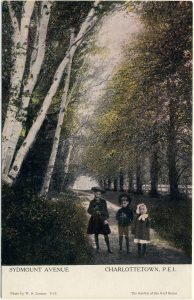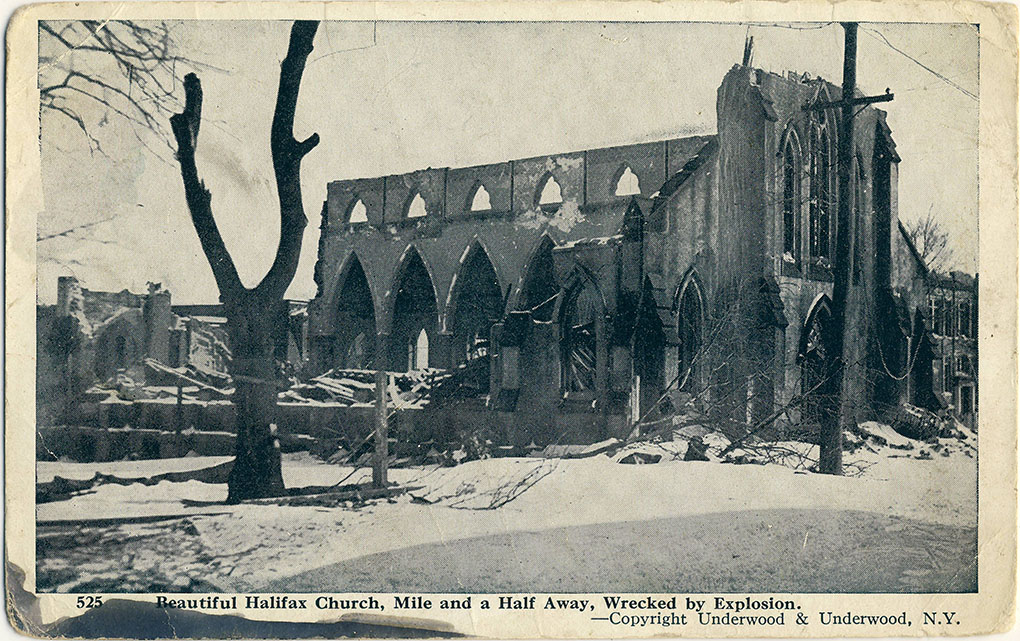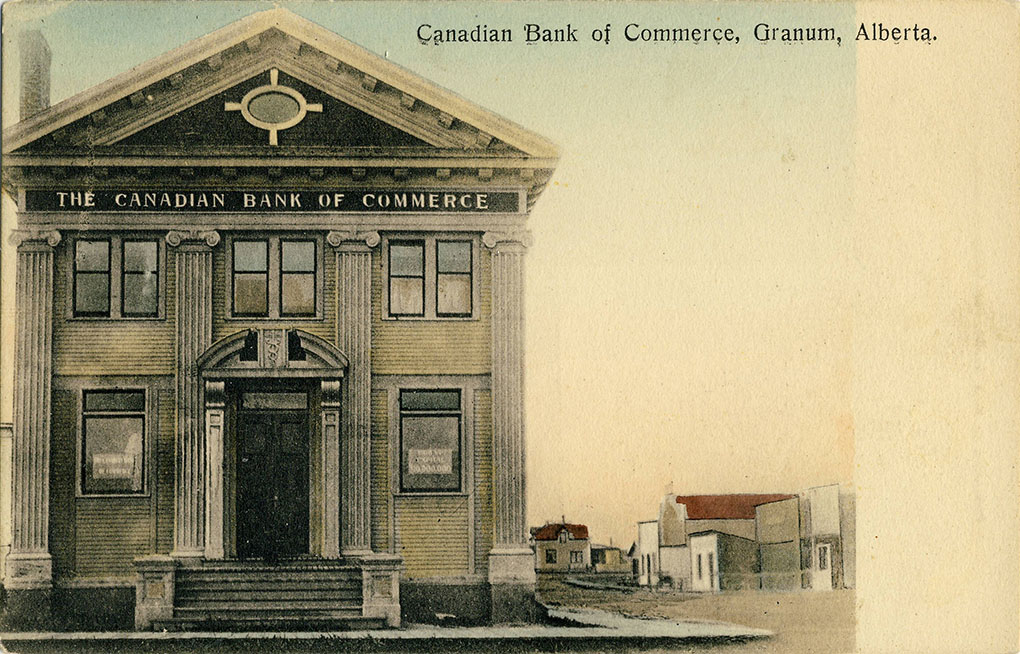Category: Prince Edward Island
CARD TALK – SPRING 2017 HIGHLIGHTS
By Andrew Cunningham
TPC members should have received the newest Card Talk this past week, a wee bit behind schedule but hopefully worth the wait. Articles this time around include John Sayers on the Halifax Explosion, particularly the cards published by Novelty Manufacturing & Art Co. of Montreal with images that were credited to Underwood & Underwood of New York, the famous stereo view publishers. The article identifies seven Novelty Manufacturing & Art Co. cards between the numbers 523 and 536 that feature Halifax explosion images — 523, 525, 528 and 533-536. Presumably the others in that range, and likely many other Novelty Manufacturing cards, also have views of the disaster. One of the cards, no. 525, “Beautiful Halifax Church, Mile and a Half Away, Wrecked by Explosion”, is seen in Figure 1.
A second series of Halifax Explosion cards identified by John was published by Cox Bros. Co. of Halifax. This series, which appears to be somewhat less common than the Novelty Manufacturing cards, is represented by ten cards in John’s collection, mostly numbered between 629 and 704, although there is also a “999” in the set. These images are very interesting and include a close-up view of the Imo — the ship that started the catastrophe by colliding with the Mont Blanc –, an image entitled “Kaye Street Methodist Church” in which there is no church other than what looks like a small pile of lumber in the midst of some broken trees, and (most interestingly, perhaps) the Cox Bros. studio itself, which was very badly damaged (there’s actually a bit of a story there, as John points out, but it’s a bit too involved to get into in a short summary like this).A second feature article in this issue is Canadian Banks on Postcards. The author looks at banks in the early twentieth-century, from provisional structures built in brand-new Prairie towns to “skyscrapers” in Winnipeg and Toronto that, in their day, were the tallest commercial buildings in the country. The cover of this issue features a Canadian Bank of Commerce branch at Granum, Alberta (Figure 2) that may look familiar to western Canadians — not because they have all been to Granum, but rather because the Bank of Commerce used the same “kit” branch — manufactured by the B.C. Mills, Timber & Trading Co. — in small towns across the West.
We also look at interesting postcard find by our member Harry Holman, whose “Straitpost“ website (incidentally) is full of interesting thoughts on Prince Edward Island postcards. Harry recently discovered a Warwick Bros. & Rutter postcard of Prince of Wales College, Charlottetown, the reverse of which contained an interesting letter from English-born flier Harry Bingham Brown (1883-1954), one of the pioneer aviators in the United States.
As was not uncommon in the years leading up to the Great War, Brown was doing the summer fair circuit and had arrived in Charlottetown in late September of 1913 to work the P.E.I. Provincial Exhibition. After a successful run at Halifax, the Charlottetown engagement was something of a disappointment (as Harry Holman notes) — Brown’s aircraft drifted away from the fairground on both of his flight attempts, disappearing quickly from the view of the eager crowds and not returning (not crashing either, but forced to land quite a distance away). Anyway, Brown wrote back to a friend in Massachusetts about how the trip was going — we won’t spill the beans on the contents of the note here, but the short message is an interesting artefact of the golden age of daredevil aviation and the sort of thing that, as a collector, is a great reward for the assiduous inspection of even the most nondescript postcards at sales and online.
This edition of Card Talk contains a lot more, including more 40th Anniversary “TPC Memories” photos, letters and observations from readers, Barb Henderson’s account of our meetings in the fall and winter of 2016-17 and our usual calendar of future meetings and postcard events across Canada and the northern U.S. If you’re not one of the in crowd that can proudly display this marvel of deltiology on your very own coffee table, then we strongly suggest that you sign up today for a TPC membership (if you act soon, we won’t send you a ginsu knife, or even two ginsu knives, but you will be able to participate in the latest instalment of our fabulous members-only online auction, which raises funds for the Club and begins in June 2017).
LEPORELLO POSTCARDS OF PRINCE EDWARD ISLAND
By H. T. Holman
Editor’s note: TPC member Harry Holman of Charlottetown, P.E.I. has started a blog — Straitpost — that focuses on the early postcards of the Island. He recently wrote this article about Leporello cards, which (for reasons that he relates) are the kind of card that contains a long strip of printed images of the place the postcard is about. The beginning his article is below, after which you can continue to Harry’s site for more. Like Prince Edward Island itself, “Straitpost” is well worth a visit.
Unless you are a Mozart aficionado or a well-educated and avid post card collector the title of this posting probably will mean absolutely nothing. Since I am neither, the term “leporello” sent me scurrying to Wikipedia where after some research the mystery was unravelled. Let’s start with the Mozart because that holds the explanation for the name. Leporello is Don Giovanni’s manservant in Mozart’s 1787 opera Don Giovanni. Don Giovanni, a young, arrogant, and sexually promiscuous nobleman, abuses and outrages everyone else in the cast until he encounters something he cannot kill, beat up, dodge, or outwit. Don Giovanni, is betrayed to a new conquest by his servant who tells her that he is unfaithful to everyone; his impressive list of seductions and conquests include 640 women and girls in Italy, 231 in Germany, 100 in France, 91 in Turkey and 1,003 in Spain. In displaying the conquests the manservant pulls the list out of the book in an accordion fold. The term leporello is applied to books and publications that use this endless page device. The leporello became quite common in the Victorian era. Panoramic scenes in travel accounts as well as images of culture and customs often used the device. After the development of photography it became an effective way to show very wide images, or a linked series of photographs.
In early postcards the leporello often takes the form of an album of mini images folded into the postcard itself. They were more commonly used in Europe but North American postcard publishers used the leporello as well although they are scarce if not rare. Because of the format the cards do not hold up well to handling. They have to have an inner pocket that protects the mini album and there is much folding and unfolding to see the images.
I hardly knew what to expect when I ordered the card from a German on-line dealer. The photos in the listing were not very good and it was obvious that the card was not in particularly good shape. The face image of the card was an uninspiring view of the winter steamer Stanley in ice but it was not one I had seen before. The photos on the sale site showed only two of the mini images and I would not have been surprised to see that any others had long since come loose and disappeared. CONTINUE READING
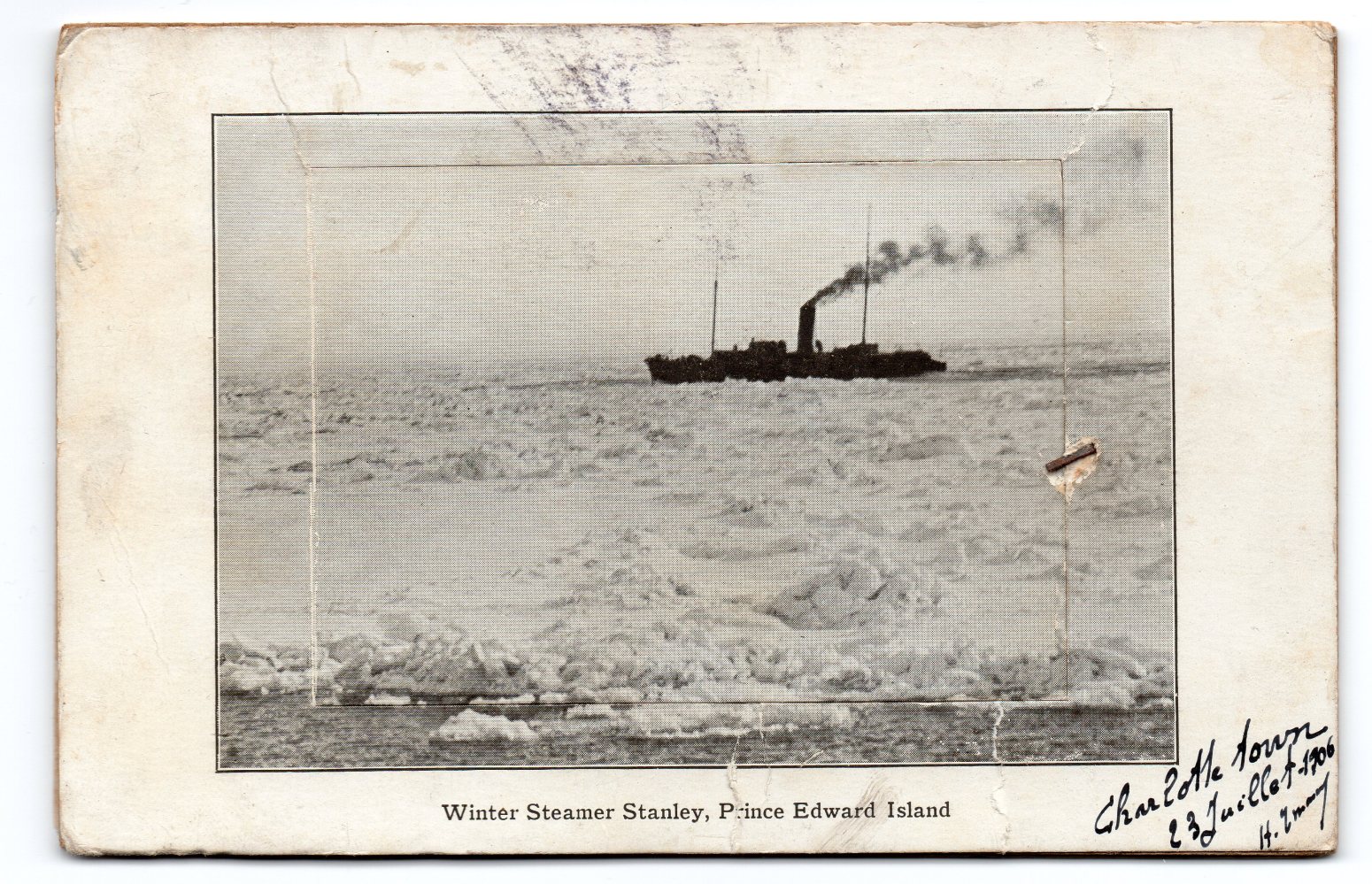
Front of Harry’s “Leporello”. The latch pin can be seen holding the image pocket closed. To see what it contained, visit his blog.
HALF A MILLION POSTCARDS
By H. T. Holman
Because almost no company records from postcard publishers have made it into archival collections, much information about the production process has been lost. The names of photographers, the nature of the contracts, wholesaling arrangements can be added to the loss of catalogues of images produced. One of the continuing questions is how many cards were produced. Historians have identified the collapse of interest following the card mania, and the subsequent withdrawal or failure of companies is attributed to over-supply but we don’t how many cards were being put into the marketplace.
For Prince Edward Island, there are a few tantalising clues. The province was certainly not immune from postcard fever and both local publishers and almost all of the national companies produced cards for the Island. The distributor for many of these companies, as well as the producer of cards under their own company name was Carter’s Bookstore (appearing as “Carter & Co.” or “C. & Co.” on later cards), who handled both retail and wholesale business in paper goods and souvenirs.
In 1904 they advertised a series of gummed stamps and souvenir photo books as well as a shipment of 5,500 postcards they had just received from their printer. However, three years later the newspaper advertising boasted that they had contracted with European manufacturers for half a million souvenir post cards “of the Beauty Spots of Prince Edward Island.” That represents more than five cards for every man, woman and child in the province. The number appears to include only view cards and does not include the many comic, holiday and topical postcards that would have rounded out their stock.
The number may be “mere puffery” but if accurate probably does not include postcards from Canadian printers such as Warwick Bros. & Rutter or McCoy Publishing in nearby Moncton and the numbers of cards could be much higher.
With numbers such as these, it is small wonder that a hundred years later there are so many surviving cards from the province.
While I am astounded by these overall numbers I still have no indication as the size of the press run of any individual card or set of cards and no idea if these numbers are reflected in other parts of the country. I would be interested in learning more about the numbers game. Perhaps TPC members could share their findings through the medium of this blog or Card Talk.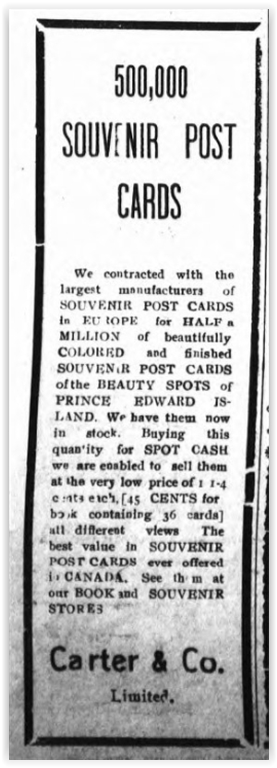
Editor’s note: We’d be interested to hear what other TPC members (and readers who are just stopping by) have learned about the volume of postcards produced and sold in their areas. To have hundreds of thousands of surviving manufactured articles from over a century ago, as anyone can see at our Club’s annual sale, one would have to think that the original “supply” must have been many, many multiples of that. But how many is a tough question to answer in the almost complete absence of records that Mr. Holman notes. You can read more of Mr. Holmes research on PEI vintage postcards in his blog “straitpost”

